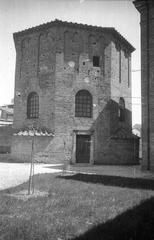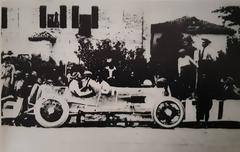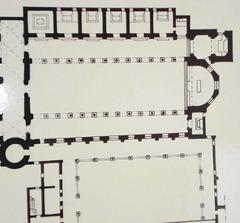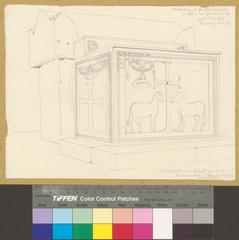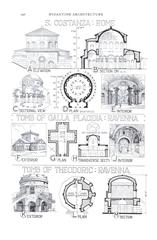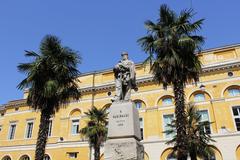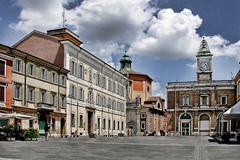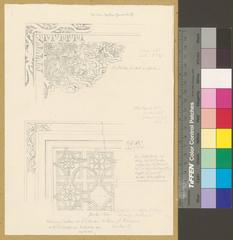
Basilica di San Francesco Ravenna: Visiting Hours, Tickets, and Historical Sites Guide
Date: 04/07/2025
Introduction
The Basilica di San Francesco in Ravenna, Italy, is a Romanesque landmark that weaves together centuries of religious devotion, artistic achievement, and literary history. Originally founded in the 5th century and transformed over time under Franciscan stewardship, the basilica not only serves as a place of worship but also stands as a testament to Ravenna’s evolving cultural landscape. Its unique flooded crypt, connections to Dante Alighieri, and understated architectural beauty make it an essential stop for travelers interested in Italy’s spiritual and artistic heritage (Italia.it; ReadySetItaly.com; Ravenna Festival).
This guide provides detailed information on the basilica’s history, architectural features, visiting hours and ticketing, accessibility, nearby attractions, and tips for an enriching experience in Ravenna.
Table of Contents
- Introduction
- History and Cultural Significance
- Architectural Highlights and Artistic Features
- The Flooded Crypt: A Unique Treasure
- Dante Alighieri and the Basilica
- Visiting the Basilica: Practical Information
- Visual and Multimedia Resources
- Frequently Asked Questions
- Summary and Final Recommendations
- References
History and Cultural Significance
Early Foundations
The origins of the Basilica di San Francesco trace back to the mid-5th century CE, a time when Ravenna was a political and religious hub of the Western Roman Empire. Archbishop Neone oversaw the initial construction, dedicating the church to Saints Peter and Paul. As Ravenna evolved through Ostrogothic and Byzantine rule, the basilica’s early Christian architecture, with its three naves and mosaic floors, reflected the city’s prominence (Italia.it).
Medieval and Franciscan Transformations
Major changes occurred in the 9th and 10th centuries, most notably with the addition of the square bell tower and the construction of the crypt to house relics. In 1261, the Franciscans took stewardship, re-dedicating the church to St. Francis of Assisi. This period solidified the basilica’s role as a monastic and cultural center, closely linked to the life and legacy of Dante Alighieri (Ravenna Festival).
Modern Restorations
Significant restoration in 1793 under Pietro Zumaglini, and further repairs following World War II, have preserved the basilica’s integrity. The Franciscans returned in 1949, revitalizing the basilica’s spiritual and cultural life (Italia.it).
Architectural Highlights and Artistic Features
Romanesque Exterior and Bell Tower
The basilica exemplifies Romanesque architecture—plain yet powerful. The 9th-century bell tower, square in plan, provides a vertical counterpoint to the basilica’s horizontal massing. The brick façade, typical of Ravenna, reflects the Franciscan ideal of humility (turismo.ra.it; peapix.com; nomads-travel-guide.com).
Interior Layout
Inside, three naves are separated by two rows of twelve columns, many repurposed from earlier Roman or Byzantine structures. The nave’s uncluttered design and flat wooden ceiling create a solemn and contemplative space, drawing attention to the raised presbytery and distinctive apse—heptagonal on the exterior and semicircular inside (turismo.ra.it).
Chapels and Artistic Heritage
Along the right nave, three Renaissance and Baroque chapels offer glimpses of later artistic influences, including works by Tullio Lombardo and Andrea Barbiani. These chapels enrich the basilica’s otherwise austere interior (turismo.ra.it).
The Flooded Crypt: A Unique Treasure
Beneath the altar lies the basilica’s most famous feature: a flooded crypt, built in the 10th century over an earlier mosaic floor from the 5th century. Due to Ravenna’s high water table and subsidence, the crypt remains underwater, creating a shimmering mirror that reflects the ancient mosaics and columns. Visitors can illuminate the crypt for a closer view by inserting a coin, often delighting in the sight of goldfish swimming among the tesserae (ravennacittadelmosaico.it; peapix.com).
The crypt’s mosaics exhibit geometric and floral motifs, as well as rare Greek and Latin inscriptions, offering insights into the early patrons and artisans of the basilica (turismo.ra.it).
Dante Alighieri and the Basilica
The basilica is indelibly linked to Dante Alighieri, who died in Ravenna in 1321. The poet’s funeral was held here, and his tomb stands adjacent to the church in the so-called “Zone of Silence,” a tranquil area that also includes the Old Franciscan Cloisters and the Dante Museum. Annual celebrations, scholarly gatherings, and cultural events reinforce the basilica’s role as a literary pilgrimage site (Ravenna Festival; readysetitaly.com).
Visiting the Basilica: Practical Information
Visiting Hours and Tickets
- Opening hours: Generally open daily from 9:00 AM to 6:00 PM. Last entry is typically at 5:30 PM. It may close temporarily for religious services or special events. Always confirm current times on the official Ravenna tourism website.
- Tickets: Entry is free. A €1 fee is required to illuminate the crypt. Guided tours or special events may require advance booking and a separate fee (Ravenna Mosaici).
Accessibility and Visitor Conduct
- Accessibility: The basilica is wheelchair accessible at the main entrance, though the crypt is only accessible via stairs. Assistance is available on request. Visitors with limited mobility may request alternative viewing options for the crypt.
- Dress code: Modest attire is required—shoulders and knees covered.
- Conduct: Maintain silence, set mobile phones to silent, and use non-flash photography only.
Guided Tours and Events
- Guided tours: Available in multiple languages and can be booked online or at the local tourist office. Specialized tours are often offered during festivals and Dante-related events.
- Events: The basilica hosts sacred music concerts, liturgical celebrations (especially on Saint Francis’s feast day, October 4th), and Dante commemorations (Ravenna Festival).
Nearby Attractions and Travel Tips
- Nearby sites: The basilica is close to several UNESCO World Heritage sites, including the Basilica di San Vitale, Mausoleum of Galla Placidia, Baptistery of Neon, and Dante’s Tomb.
- Travel tips: The basilica is within walking distance of the city center and easily accessible by public transport. Visit in the morning or early afternoon for optimal lighting in the crypt. Wear comfortable shoes due to uneven flooring.
- Amenities: A small bookshop inside offers guidebooks and souvenirs. Public restrooms are available in the nearby city center.
Visual and Multimedia Resources
- Virtual tours and interactive maps are available on Ravenna’s official tourism website.
- Images:
- Facade of Basilica di San Francesco in Ravenna – Romanesque brickwork and bell tower.
- Flooded crypt with ancient mosaics – Water reflects colorful tesserae and stone columns.
- Interior nave and columns – Wide nave with repurposed Roman columns and arches.
Frequently Asked Questions
Q: What are the Basilica di San Francesco visiting hours?
A: Typically 9:00 AM to 6:00 PM daily; check the official website for updates.
Q: Is there an admission fee?
A: Entry is free; a €1 fee applies to illuminate the crypt.
Q: Is the basilica accessible for visitors with disabilities?
A: Main areas are accessible; the crypt requires stairs, but assistance or alternative viewing is available.
Q: Are guided tours available?
A: Yes, they can be arranged through local agencies or online.
Q: What nearby attractions should I visit?
A: Basilica di San Vitale, Mausoleum of Galla Placidia, Baptistery of Neon, and Dante’s Tomb are all nearby.
Summary and Final Recommendations
The Basilica di San Francesco is a serene, historically rich destination that encapsulates Ravenna’s religious, artistic, and literary traditions. From its Romanesque architecture and atmospheric flooded crypt to its deep ties with Dante Alighieri, the basilica offers a multi-layered experience. Take time to check opening hours, consider a guided tour, and explore the nearby constellation of historical sites for a well-rounded visit.
For tailored travel tips, event updates, and further cultural insights, download the Audiala app, follow our blog, and connect with us on social media. Make the most of your visit to Ravenna by immersing yourself in the living history of the Basilica di San Francesco.
References
- Basilica di San Francesco in Ravenna: History, Architecture, and Visitor Guide, 2024, Italia.it (Italia.it)
- Cultural and Religious Significance of the Basilica di San Francesco in Ravenna: Visiting Hours, Tickets, and Historical Insights, 2024, Ditisitalie.nl (ditisitalie.nl)
- What to See in Ravenna, 2024, ReadySetItaly.com (ReadySetItaly.com)
- Basilica di San Francesco, Ravenna Festival, 2024 (Ravenna Festival)
- Basilica di San Francesco Ravenna: A Romanesque Masterpiece and Must-Visit Historical Site, 2024, Turismo.ra.it (turismo.ra.it)
- Basilica di San Francesco Visiting Hours, Tickets & Guide to Ravenna’s Historic Site, 2024, VisitRavenna.it (VisitRavenna.it)
- Basilica of San Francesco, Ravennacittadelmosaico.it (ravennacittadelmosaico.it)



